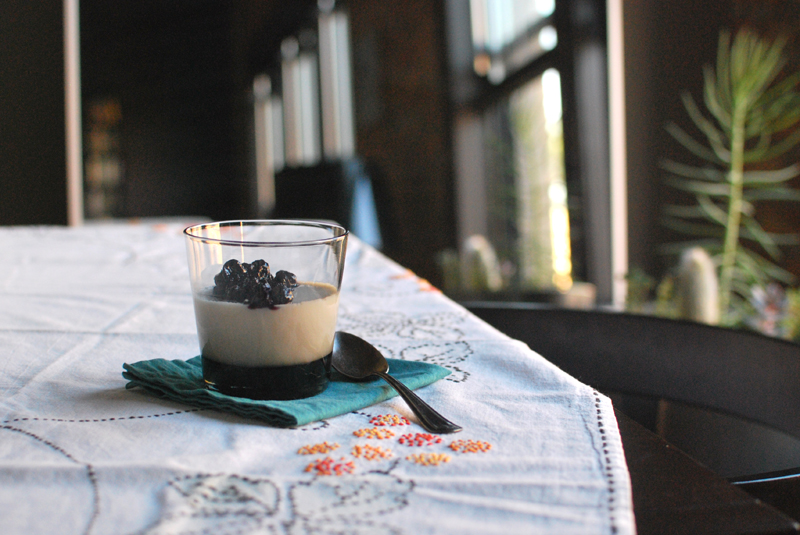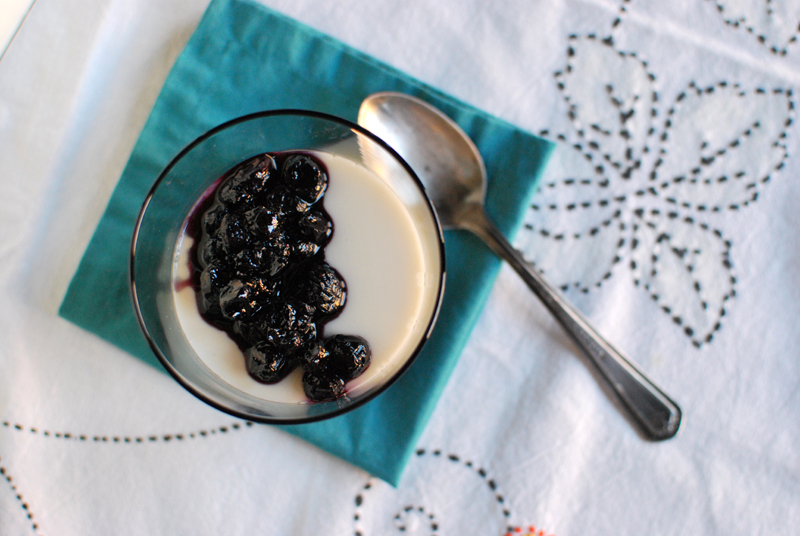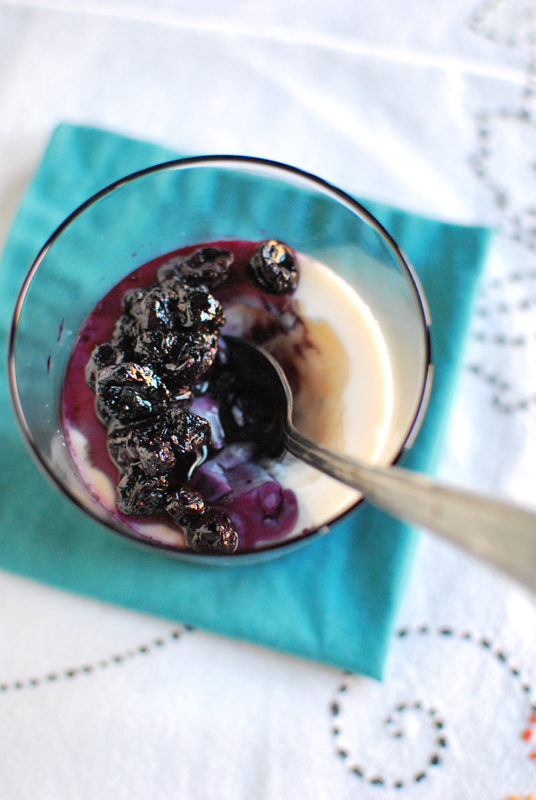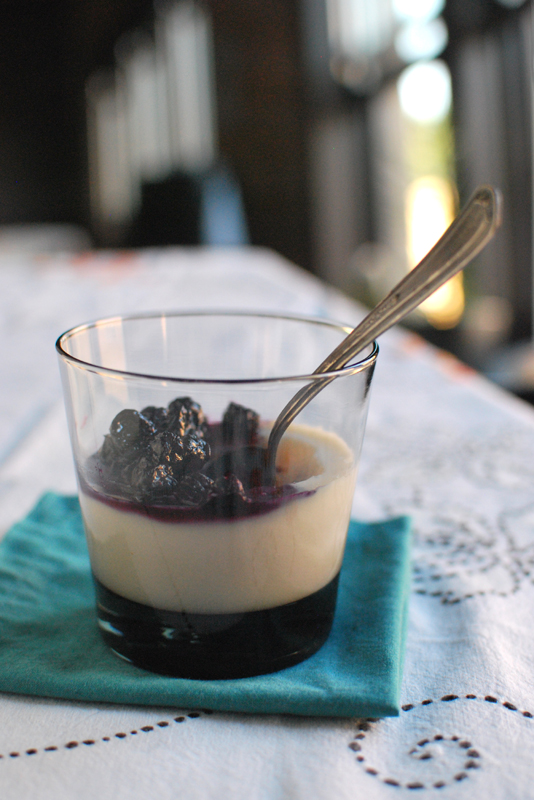We recently invited a dear friend over for dinner, a dear friend who is going a-courtin’ with a sweet new fellow. This fellow happens to be vegan, which isn’t an issue until you invite him over for your annual Kentucky Derby party and realize three hours and a few mint juleps into the party that absolutely everything you’ve served has some sort of non-vegan ingredient in it so you have to improvise some off-the-cuff guacamole with one avocado (and no tomatoes, red onions, or cilantro around) before the poor guy passes out.
Luckily, he didn’t hold that against me, and agreed to return for a proper dinner. Little did he know that I had never prepared an entirely vegan three-course meal before. I do love a menu-planning challenge.
The appetizer and entrée were simple enough: a creamy dip of roasted eggplant and tahini with pita wedges, followed by a dish of lentils, hazelnuts, celeriac, and herbs, both recipes from my new favorite cookbook, Yotam Ottolenghi’s Plenty. But dessert… ah, dessert was a conundrum all on its own. Complicating the issue, our oven had obstinately refused to turn on one morning a week or so earlier, and the repairs had not yet occurred.
So. A dessert. Vegan. With no oven. Hmmmm. Obstinate myself, I refused to resort to a platter of cut-up fruit. My pride was at stake here. I could do better than a fig on a plate.
My first thought was chocolate mousse, my go-to recipe that uses olive oil (vegan!) and a soupçon of Bourbon (also vegan!). It didn’t require an oven, always went over well, and could be made in advance. I’d just get some nice cream and fold in the… ohhhhh.
Derp.
After chocolate mousse, I often turn to panna cotta for a sophisticated end to a dinner. But panna cotta (literally, “cooked cream”) is about one of the least vegan desserts I can think of. At its basest level, it’s just milk and/or cream, thickened with gelatin (it’s made of hooves, you know!). Vegan panna cotta? It sounds a little crazy.
But, inspired by an old post on Chez Pim that I recently came across, it occurred to me to swap the cow’s milk for almond milk, and the gelatin for agar agar. Suddenly, the idea of a vegan panna cotta wasn’t so crazy.
Finding agar wasn’t tricky. The only tricky thing was the lack of information on how to use it. Even in pastry school, the extent of our education thereof consisted essentially of a footnote under “gelatin”. (To paraphrase: “Agar is a weird thickener you can use, it’s made of seaweed. Good luck.”)
Faced with recipes containing wildly varying proportions of agar-to-liquid, hazy descriptions (“pretty firm” doesn’t help), and the fact that agar is sold variously as powder, flakes, or strips, I ended up just testing it myself. I boiled cups of water with increasing amounts of powdered agar until, when the mixture was chilled, the consistency was just right. And trust me, if you overdo it, you can bounce the stuff like a rubber ball. Kinda neat, but you do not want to eat that.
The rest of the recipe came together easily, especially after finding this dairy-free panna cotta on Tartelette. Her idea of using non-dairy creamer to replicate the thickness of cream is head-slappingly obvious, but I wouldn’t have thought of it. Planning to serve the verrines with a blueberry compote, I decreased the sugar for a less saccharine base, and tossed in a few drops of almond extract to boost the almond-y flavor.
Already feeling pleased with myself, I was even happier when the “panna” cotta was greeted with rave reviews. The almond and soy milks made for a lighter, slightly nuttier flavor than a traditional recipe, one that was ideal for a hot summer night. As for the texture, it was exactly what I wanted: soft and yielding, just barely able to hold itself upright if one attempted to unmold it (though I never do). Due to the nature of agar, you can never really achieve quite the same melting quality you can get with gelatin, but, used judiciously, you can get pretty darn close.
Judging by the scraped-clean glasses left after the dinner, I’d say everyone else thought it was darn close, too.
Almond Milk Panna Cotta
Adapted from Tartelette
Makes 4 servings
I prefer to refer to this as “Almond Milk Panna Cotta”, as it sounds more purposeful and enticing than “Vegan Panna Cotta”, which sounds like an exercise in futility, or a consolation prize. Almond milk has a delight all its own; it just so happens that I made sure that the rest of the ingredients were vegan-friendly as well.
A word on agar: any sort (powdered, sheet, etc.) will of course work here. If you’ve never used it, I suggest trying it out first. To do so, place a small plate in the freezer, and measure out 1 cup of water. Dissolve 1/4 teaspoon powdered agar (or equivalent) in a pan in a spoonful of the water. Add remaining water, and bring to a boil for 30 seconds. Cool slightly, and pour a little onto the frozen plate. Chill the plate in the refrigerator. It should gel within 5-10 minutes; if it doesn’t, use a little more agar and repeat. If it’s too tough, decrease the amount of agar. Repeat until you get a texture you like. Sounds like a pain, I know, but it’s not as much of a pain as having your dessert turn out tough and rubbery, or not even set.
1/2 teaspoon powdered agar
1 cup unsweetened almond milk
1 cup non-dairy creamer of choice
1/4 cup sugar
1/16 – 1/8 teaspoon almond extract, depending on strength of extract and how much almond flavor you want
Optional: Blueberry Compote (recipe below)
1. Place agar in a small saucepan. Drizzle in a spoonful of almond milk, and stir to dissolve, adding more liquid if necessary. Add remaining almond milk, non-dairy creamer, and sugar. Bring to a boil over medium-high heat, stirring to dissolve the sugar.
2. Boil for 30 seconds, stirring constantly, to make sure the agar will set. The mixture will probably threaten to boil over; if it does, briefly remove it from the heat until the foam subsides. After 30 seconds, remove from the heat and let cool to about room temperature.
3. Add the almond extract, and divide evenly into 4 ramekins or glasses. Let cool completely, if necessary, before covering with plastic wrap and refrigerating for at least 3 hours, or overnight. Serve with Blueberry Compote spooned over the tops, if desired.
Blueberry Compote
Adapted from Ready for Dessert, by David Lebovitz
Makes about 1 cup
I adore this sauce, especially over panna cotta, as it is suggested in the cookbook. The gin is the perfect “what IS that?” touch. Taste your blueberries before adding the sugar. If they’re very sweet, you might not need much sugar. If they’re a little wan, use more. Remember, after cooking, you can always add a little more sweetness if need be.
12 ounces blueberries, fresh or unthawed frozen
1-2 tablespoons sugar, depending on sweetness of berries, plus extra as needed
4 teaspoons gin
Zest of 1 lemon, plus a light squeeze of its juice
1 bay leaf
1 three-fingered pinch salt
1. Combine all ingredients in a small pan. Bring to a rapid simmer over medium heat, stirring to make sure sugar is dissolved. Simmer until thickened slightly, 5 to 15 minutes, depending on how juicy the berries are. (Compote will thicken further after chilling.) Discard the bay leaf, and taste the compote. Add additional sugar or splashes of lemon juice as needed. Chill until ready to use.




